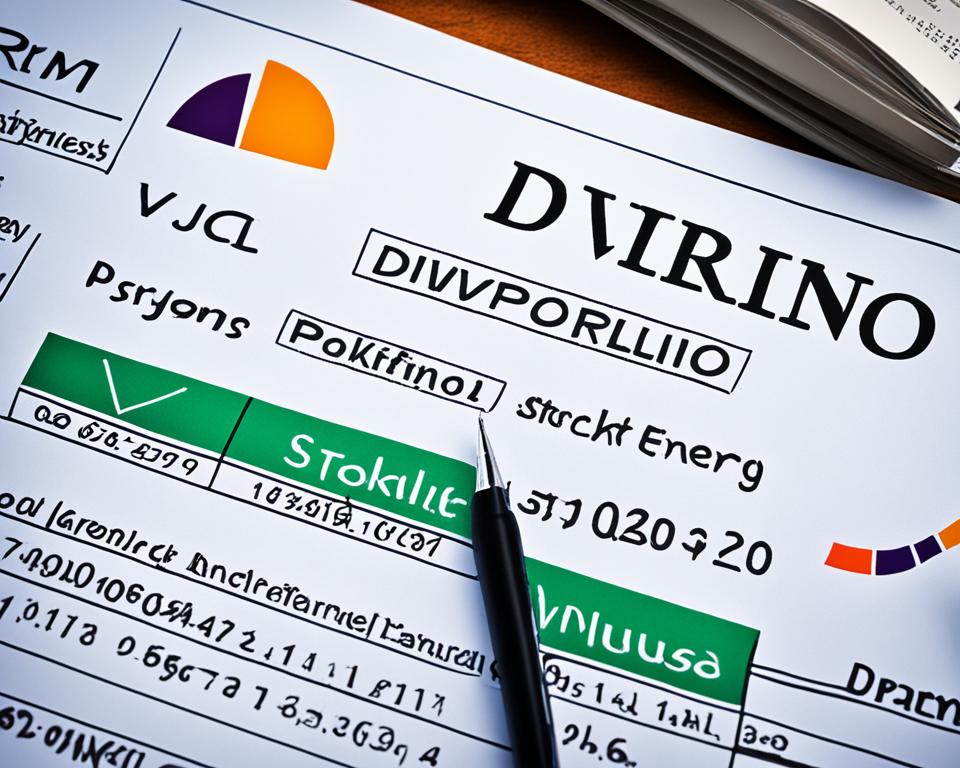Embarking on the path of dividend investing can open doors to passive income and a growing wealth portfolio, but it’s a journey that comes with its own set of challenges and potential missteps. Dividend investing mistakes can impede an investor’s progress towards their financial goals, often due to seductive yet unsustainable high yields or a lack of thorough due diligence. Recognizing common errors in dividend investing is the first step to charting a steadier course. Investors must resist the risks hidden behind generous yields and prioritize a balanced approach that takes into account the pitfalls of dividend investing. With an eye for sensible yield expectations and strategic sector allocation, investors can sidestep avoidable mistakes in dividend investing and cultivate a robust income-generating portfolio.
To navigate these waters successfully, one must understand the intricacies of dividend yields, acknowledge the importance of portfolio diversification, and stay alert to shifts in the financial landscape. Combined with a disciplined review process and a keen insight into the financial health of dividend-offering companies, investors can transform common challenges into opportunities for lasting growth.
Key Takeaways
- High dividend yields may mask underlying financial struggles, so investor caution is warranted.
- A diversified portfolio can lessen the impact of sector-specific downturns.
- Incremental dividend growth is essential for maintaining buying power over time.
- Regular portfolio review helps investors respond promptly to changing market conditions.
- An understanding of ex-dividend dates ensures timely dividend capturing.
- Avoiding dividend traps by assessing company fundamentals is crucial for long-term success.
Understanding Dividend Yields: Managing Expectations
For those looking toward dividend investing as a pathway to financial stability, navigating the complexities of dividend yield management is crucial. A discerning eye is necessary to distill enticing yields from ones that appropriately balance risk and return. In this journey, investors must steer clear of the siren call of high yields without succumbing to the perils that often accompany them. Let’s delve into the nuances of high dividends and explore the fundamental principles of instituting sustainable dividend policies.
Resisting High Yield Temptations
Faced with the allure of high yields, investors may find it challenging to resist what seem like lucrative opportunities. However, seasoned wealth builders understand that extraordinary yields frequently come intertwined with high dividend risks. An inflated yield can often mask a declining share price — a harbinger of potential financial strife within a company. Such yields might offer short-term appeal, but the implications of a slashed or suspended dividend can be detrimental to the investor’s aspirations for long-term growth. The solution lies, therefore, in resisting short-term temptations and grounding investment decisions in robust analysis and strategic foresight.
Assessing Dividend Sustainability
The pursuit of sustainability in dividends dictates a disciplined approach, one that scrutinizes the yield in the context of the company’s earnings and overall financial fortitude. A dividend is only as reliable as the company’s capacity to endure and thrive through economic turbulences. Wise investors look beyond the present yield, investigating the dividend’s growth trajectory and the company’s adherence to sound financial governance. The cornerstone of this approach is a commitment to sustainable dividend policies that signal both the company’s resilience and its dedication to honoring shareholder trust through consistent dividend payouts.
The concept of sustainability ultimately informs every facet of dividend yield management, encouraging investors to prioritize stability and dependability over mercurial and potentially misleading high yields. As investors internalize these principles and remain vigilant in their application, the path to a verdant, yield-bearing investment portfolio becomes clearer and more attainable.
Diversifying Your Dividend Portfolio
In the realm of dividend investing, falling prey to a homogenous portfolio can spell trouble for investors aiming for long-term financial health. The savvy investor’s mantra for success lies in diversification in dividend investing. It’s a strategy that doesn’t just sprinkle the investment seeds broadly but does so with an informed and deliberate sector allocation, essential for portfolio risk reduction.
The heavy reliance on telecoms and utilities for dependable dividends is a narrative of the past. Today’s dynamic market offers a cornucopia of dividend-paying companies spanning an array of industries. This shift allows for generous latitude in selecting a medley of sectors, each complementing the other, to form a well-rounded portfolio. It’s a leap from traditional methods, embracing the possibilities yielded by the broad spectrum of opportunities in various sectors – from technology to healthcare, from consumer goods to financial services.
To illustrate the benefits of diversification, consider a portfolio overly concentrated in the energy sector. Should geopolitical events roil the markets, the impact on an undiversified portfolio could be far more pronounced than one with investments spread across, say, consumer staples, real estate, and healthcare – sectors historically less sensitive to such upheavals.
Let’s delve deeper into the tactical application of this strategy. An elegantly diverse portfolio might include investments in burgeoning tech firms, esteemed blue-chip companies with a consistent dividend history, and perhaps a touch of international flavor with exposure to emerging market stocks offering dividends. It’s about creating a harmonious balance that mitigates risks and hedges against market volatility.
Dividend investors must adapt to an ever-shifting economic landscape. By cultivating a diverse dividend portfolio, investors are more poised to weather market uncertainties and harness the array of dividends proffered by different industries. Enriching one’s portfolio through thoughtful diversification is the linchpin in a resilient, income-generating investment strategy.
Recognizing the Role of Dividend Growth
Investors looking for sustained profit in the stock market often turn to dividend growth investing, a method that focuses keenly on the trajectory of a company’s dividends over time. By examining the historical pattern of incremental dividend increases, one can gauge the health and growth potential of a business, two indicators highly regarded by long-term investors. When a company consistently raises its dividends, it’s typically a sign of financial health and a robust business model—a beacon of stability amidst the turbulent seas of the market.

As part of this rigorous investment strategy, monitoring the pace of dividend increases is as revealing as monitoring their size. It’s not merely about current yields; it’s about the promise of long-term investment growth. Let’s further explore why incremental gains and subsequent dividend increases are critical to investment success.
Importance of Incremental Gains
The allure of a hefty, immediate dividend yield can be enticing, but the sage investor understands the long game is won through incremental gains. Small, regular increases in dividends reflect a company’s evolving profitability and reliability, making it an appealing choice for the patient investor. These increases are vital, not just as a means of income, but as signals of a company’s enduring commitment to its shareholders and an indication of its rising market confidence.
Long-Term Impact of Dividend Increases
When dividends grow consistently, they serve as a hedge against inflation, ensuring that the purchasing power of the dividend income doesn’t erode over time. This pattern of growth benefits investors by expanding their income stream in a way that’s intended to outpace the creeping advance of inflation. Beyond the immediate benefit of more significant cash flow, such a trend can also translate into capital appreciation, as a company’s share price often escalates in acknowledgment of its financial resilience and capacity for growth.
| Year | Dividend Per Share | Year-Over-Year Increase |
|---|---|---|
| Year 1 | $1.20 | – |
| Year 2 | $1.25 | 4.2% |
| Year 3 | $1.30 | 4.0% |
| Year 4 | $1.36 | 4.6% |
| Year 5 | $1.42 | 4.4% |
While high single-year jumps in dividends might make headlines, it is the consistent annual growth, as demonstrated in the table above, that truly maps out a trajectory towards achieving substantial long-term investment growth. The intersection of reliable dividend payouts and the potential for stock price appreciation makes dividend growth investing a cornerstone strategy for many focused on securing a prosperous financial future.
Avoiding the Pitfalls of Market Timing
The landscape of dividend investing strategy is often fraught with the hazards of market timing mistakes. Successful investors understand that while the allure of predicting stock market highs and lows seems profitable, the reality is far more complex and unforgiving. The key to a prudent dividend investment is not in the elusive art of market timing but in the steadfast pursuit of disciplined investment mechanisms such as Dividend Reinvestment Plans (DRIPs).
Dividend Reinvestment Plans offer a structured approach to investing, circumventing the necessity to speculate on market trends. With these plans in place, investors commit to a long-term horizon, confidently steering their portfolio without the need to outguess market fluctuations. The entry barriers to DRIPs are characteristically low, offering an accessible gateway to investors of all levels. Moreover, the minimal initial fees and lack of maintenance fees present an economical pathway to bolstering one’s investment portfolio.
The strategy to sidestep market timing mistakes is not merely a defensive tactic but a proactive one. Systematic investing through DRIPs epitomizes the spirit of methodical growth, affording investors the ability to incrementally enhance their holdings. Through consistent reinvestment of dividends, regardless of market condition, investors are poised to compound their gains and expand their investment corpus without falling prey to the pitfalls of fluctuating market sentiment.
In essence, the disciplined investor who eschews the unpredictable nature of market timing in favor of meticulous, systematic investment, lays a solid foundation for their dividend investing strategy. This steady approach stands as a beacon of rational investment methodology, promoting growth, stability, and resilience in the face of market unpredictability.
Diligence in Researching Dividend Dates
For those who are serious about strategic dividend collecting, grasping the ex-dividend date importance is a cornerstone of investment planning. Skilled investors understand that dividends aren’t simply a matter of chance but the result of careful and calculated decisions, particularly concerning the timing of stock purchases and sales.
Indeed, a keen awareness of dividend dates, especially the ex-dividend date, is what allows investors to secure their desired dividend payouts. In the universe of dividend investing, these dates dictate when the baton of benefit is passed to the investor, making them crucial waypoints in a journey towards successful income generation.
Understanding Ex-Dividend Dates
The ex-dividend date represents a decisive cut-off in the world of dividends. To be clear, owning a stock before this critical date is what secures an investor’s claim to the next dividend payout. Failure to do so implies missing out on the forthcoming disbursement, which could disrupt the income stream an investor may be relying on.
Strategic Timing of Purchases and Sales
The art and science of strategic dividend collecting hinge greatly on one’s ability to synchronize their investment moves with these pivotal dates. By pinpointing the perfect moments for both purchasing shares—just before the ex-dividend date—and selling them, the investor positions themselves to optimize their dividend potential.
This strategy does not require psychic abilities but does demand diligence and careful planning. Accurate, up-to-date information on ex-dividend dates is the investor’s map to treasure—a proactive measure ensuring that dividends bolster income rather than slip through the cracks of mismanagement.
A practical illustration of this might look like a calendar of upcoming ex-dividend dates, serving as a guide for when to initiate or close positions. With the understanding that buying shares prior to this date secures the forthcoming dividend, and selling them before means forfeiting it, the strategy comes to life in the realm of investment calendars and alerts. This is the scaffolding upon which successful dividend collection strategies are built, encompassing a wide array of dates and companies.
In summary, the significance of dividend dates cannot be overstated in the broad spectrum of investment strategies. Those who take the time to learn and apply the intricacies of dividend date management will likely find themselves supplementing their portfolio with consistent, strategic gains—turning time into dividends, and dividends into dollars.
Identifying and Avoiding Dividend Traps
Dividend investing, while potentially lucrative, carries the risk of falling into dividend traps. These are ticklish situations where companies lure investors with enticingly high dividends—often yields that are not sustainable in the long run. Diligence in identifying dividend traps is key to maintaining the financial health of one’s portfolio and avoiding the painful aftermath of cut dividends.
But what signifies a dividend trap, and how can an investor stay clear of them? We scrutinize the symptoms that typically precede the snare and propose strategies for juxtaposing tempting yields against the backdrop of solid financial health.
Indicators of Unsustainable Dividends
A vigilant investor, at the scent of unsustainable dividends, drills down on a company’s financial reports. Declining earnings and surging payout ratios—the percentage of income given out as dividends—often wave red flags. When earnings are on a downslide, a high dividend yield may simply be the aftershock of a dwindling share price. This combination paves a path straight to a dividend trap.
Another tell-tale sign of ailing dividends is financial distress. If a company is struggling with high levels of debt or slipping into competitive irrelevance, continuing to pay high dividends becomes untenable. Such scenarios demand a more nuanced consideration than the mere attractiveness of a yield percentage plastered on an annual report.
Balancing Yield with Financial Health
Fostering a balanced outlook means also appraising a dividend through the lens of the company’s overall financial health. Smart investing isn’t swayed by yield alone—it requires evaluating leverage, cash flow patterns, and how a business holds up against industry headwinds. A robust operating margin, low debt-to-equity ratio, and a stable history of not just paying but also modestly increasing dividends are all brushstrokes in the portrait of a healthy dividend-paying company.
Truth be told, the quest for dividends is far from gambling—it’s a strategic pursuit. It’s about prizing the balance, the calculated choice that weighs the allure of dividends with the enduring strength of a company. As such, identifying dividend traps and sidestepping them with finesse is not just about protecting one’s capital—it’s about nurturing it through prudent, well-informed investment decisions.
Navigating Taxes on Dividend Income
With the allure of passive income through dividends comes the inevitable caveat of tax considerations — key elements of dividend tax navigation. For investors journeying through the realms of dividend collecting, grasping the nuances between qualified dividends and non-qualified dividends promises a clearer path to tax-efficient investing. How dividends are taxed can significantly influence net returns and an investor’s overall financial strategy.
Qualified vs. Non-Qualified Dividends
Determining the nature of dividends — whether qualified or non-qualified — is paramount as it directly impacts how dividends are taxed. Qualified dividends enjoy favored tax treatment, generally being taxed at the lower capital gains tax rates, whereas non-qualified counterparts bear taxes at the higher ordinary income tax rates. Criteria such as the dividend payer’s corporate structure and the investor’s holding period light the way toward maximizing after-tax income.
Planning for Tax Efficiency
With a keen eye for detail and a forward-looking approach, investors can align their portfolios for more tax-efficient investing. Strategic planning includes being mindful of holding periods and the mix of investments in one’s portfolio to take advantage of the preferential tax rates. For those wielding a diversified assortment of dividend stocks, mutual funds, or exchange-traded funds, understanding the tax implications propels one towards a sage route, surmounting the tax hurdles that often diminish investment gains.
- Awareness of company structure and holding period for qualified dividends
- Consideration of total portfolio composition for tax impacts
- Selection of investment vehicles in line with tax efficiency goals
Transcending the mere act of collecting dividends, the astute investor orchestrates their holdings with a precise understanding of tax regulations. Engaging with qualified dividends where possible and shrewdly managing non-qualified dividends ensures a portfolio that not only grows but also retains more of its fruits in a tax-efficient manner.
Prudent Investment in Dividend Paying Stocks
When it comes to building a solid financial foundation, a prudent stock evaluation can be the decisive factor between a thriving investment portfolio and one that falters. Investors seeking sustainable growth through dividends must delve into the dividend stock fundamentals, ensuring each chosen stock stands up to rigorous scrutiny and aligns with their strategy for a total return on investment.
Evaluating Company Fundamentals
Embarking on a journey with dividend investing requires an investor to appraise company fundamentals diligently. This isn’t about skimming over the surface-level figures; it involves a keen analysis of the company’s financial health, its dominant market position, and its resilience against economic cycles. The bedrock of a reputable dividend-paying stock is often found in low debt levels, strategic resource allocation, and prospects for future earnings growth. These considerations are critical in predicting whether a company can maintain or increase its dividend payout over time and evade the so-called dividend traps.
Assessing the Total Return Potential
An investor’s pursuit of dividends should always regard the broader picture of total return, which includes both the income received from dividends and the potential for capital appreciation. Companies with a history of steady revenue growth, for instance, not only exhibit the capacity to pay out dividends but may also promise growth in the stock’s market value. Through a balanced approach that values consistent dividend payout and upside potential, investors can anticipate a comprehensive return on their investments that compounds over the years.
| Company | Dividend Yield | 5-Year Revenue Growth | Debt-to-Equity Ratio | 5-Year Dividend Growth |
|---|---|---|---|---|
| Company A | 3.5% | 6% | 0.4 | 5% |
| Company B | 2.8% | 9% | 0.3 | 8% |
| Company C | 4.2% | -1% | 0.8 | 2% |
| Company D | 3.0% | 4% | 0.2 | 10% |
Investors should uphold a judicious approach to selecting dividend-paying stocks, guided by comprehensive evaluations and a long-term outlook. By aligning dividend yields with financial health and growth indicators, the potential for a prudent and profitable dividend investment strategy becomes palpable.
Opting for Dividends over Capital Gains
Investors at the crossroads of choosing dividends over capital gains confront a seminal decision in their financial journey. The merits of each approach encapsulate distinct financial goals and investment philosophies that differ in structure and outcomes. Many investors find themselves drawn to the allure of dividends, hoping to tap into the ongoing income stream they provide. In contrast, traditional value seekers aim for capital gains, relying on the appreciation in the value of underpriced securities to achieve their investment objectives.

The strategy of prioritizing dividends has gained traction as investors look beyond the surface appeal of capital gains. A cornerstoned approach to capital gains versus dividends is grounded in the investor’s lifestyle needs, risk tolerance, and time horizon. Dividends offer a clearer path to financial predictability and, in some cases, a demonstration of a company’s financial health and stability. This approach aligns with the ethos of investors who prefer a tangible and recurring benefit from their investments, as opposed to potential future gains.
Dividend growth further solidifies this strategy. Investors keen on dividend-paying stocks tend to prioritize those with reliable pay-out histories and the potential for future increases. Their investment strategy thus contributes to total returns, factoring in both the income received from dividends and the appreciation of stock value over time.
- Consistent dividend payments serve as a reflection of a company’s financial health.
- Income generated from dividends can complement or even outpace capital gains.
- Dividend growth demonstrates a company’s commitment to delivering shareholder value.
- Reinvested dividends can exponentiate wealth growth through compounding.
With dividend-focused investing, recognizing the interlaced relationship between dividends and potential capital gains is critical. This balanced perspective offers a holistic view of an asset’s value and underscores the importance of a well-curated, income-generating portfolio. Therefore, while the debate of capital gains versus dividends continues, the inclination towards dividends is more than just a tactical choice—it’s a strategic framework for those seeking steadiness amidst the capricious nature of the market.
Dividend Investing Mistakes Related to Company Selection
A crucial aspect of successful dividend investing hinges on the adept company selection for dividends. Investors often limit their scope to conventional sectors, which can lead to missed opportunities and undue concentration risks. Wealth accumulation through dividends need not be confined to the traditional suspects; broadening the investment universe is essential to capture diverse income streams.
Looking Beyond Financial Sector Stereotypes
The tendency to oversimplify the investment landscape can lead investors to harbor financial sector misconceptions. While utilities and telecommunications have been perennial favorites for dividend seekers, it’s pivotal to challenge the stereotype that they are the sole providers of reliable dividends. Forward-thinking investors are now looking at sectors previously overlooked for dividend potential, recognizing that innovation and diversification in various industries can yield stable dividends without compromising growth.
Investing in Companies with Durable Business Models
To ensure a gratifying journey in dividend investing, one must consider companies that exemplify durable business models. These are entities adapted to withstand economic shifts and most poised to sustain and potentially increase dividends. Such companies often operate in industries with high entry barriers, enjoy brand loyalty, or possess proprietary technologies that provide an enduring competitive edge.
Selecting companies with these characteristics leads to an income-oriented portfolio that can thrive in various market conditions, navigating through economic cycles with resilience. The idea transcends just surviving market downturns; it’s about identifying businesses that can flourish and maintain investor confidence through unyielding long-term dividend payouts.
Misconceptions about Dividend Investing and Value Investing
In the investment community, discussions often revolve around the comparative merits of dividends vs. value investing. It’s commonplace to find these strategies interwoven in investment dialogues, yet striking distinctions define each approach. The essence of dividend investing is income generation against the capital appreciation sought by value investing. Analyzing these divergent paths sheds light on their unique attributes, allowing investors to align their portfolios with clear, strategic financial outcomes.
Distinguishing Between Income and Valuation Focus
At its core, dividend investing prioritizes the steady flow of income, an aspect that beckons those with a penchant for income-focused investing. Dividends provide an ongoing return on investment directly to the shareholders and can be indicative of a company’s financial vitality and commitment to shareholder value. In stark contrast, value investing is characterized by the pursuit of capital gains where the main objective is purchasing stocks perceived to be below their intrinsic value and selling them once they appreciate. It’s a game of patience and predictive prowess focused on valuation rather than immediate income.
Aligning Strategic Goals with Dividend Choices
The alignment of investment choices with strategic financial goals is central to the philosophy of investors leaning towards dividends. When income generation takes precedence, the stability and potential growth of dividends are of utmost concern, factors that strategic dividend alignment seeks to prioritize. Such investors place less emphasis on finding temporarily undervalued stocks—a pursuit more common among traditional value investors—and more on sourcing equities with solid records of sustainable, and preferably rising, dividends.
To effectively avoid the pitfalls commonly associated with dividend traps, investors must script a nuanced narrative that champions dividend resilience over high yields that may not endure. Therefore, while dividend and value investing may perfunctorily intersect, it is the nuanced understanding of each strategy’s goal—a reliable income versus valuation advantages—that ultimately governs their differentiation and application.
Overlooking the Impact of Inflation on Dividend Returns
Inflation’s relentless encroachment on economic stability poses a real threat to the static income from dividends. Investors focused on dividend returns are urged to acknowledge how inflation can dilute the purchasing power of their dividend income, requiring adaptive approaches to mitigate inflation risks. Aligning one’s dividend strategy adaptation with inflationary expectations is not just prudent; it’s essential for preserving the value of their passive income in real terms over the long term.

Mitigating Inflationary Pressures
To combat the erosive effects of inflation on dividends, thoughtful investors may integrate stocks of companies with a history of resilient and growing dividends into their portfolios. Emphasizing sectors that traditionally thrive or remain unaffected during inflationary times—such as consumer staples, healthcare, or certain utilities—can aid in mitigating inflation risks. Furthermore, companies with inflation-indexed revenues or those providing essential services can act as a bulwark against the tide of inflation.
Adjusting Dividend Strategies in Inflationary Periods
Agility in the face of economic change is the hallmark of a savvy investor’s ethos. Recognizing the interplay between inflation and dividend returns prompts a proactive reassessment of one’s holdings. Here, the aim is identifying stocks of companies with the inherent strength to withstand inflationary headwinds—either through pricing power, cost controls, or diversified revenue streams. The dividends from these entities tend to not only offer shelter against inflation but also present growth opportunities in a climate where both are hard to come by.
| Company | Sector | Dividend Yield | 5-Year Dividend CAGR* | Inflation Resilience |
|---|---|---|---|---|
| Company X | Consumer Staples | 3.0% | 5% | High |
| Company Y | Healthcare | 1.8% | 7% | Medium |
| Company Z | Utilities | 4.0% | 3% | High |
| Company W | Technology | 0.8% | 10% | Low |
*CAGR: Compound Annual Growth Rate
Conclusion
Embarking on the journey of dividend investing involves a comprehensive understanding of nuanced strategies and sound financial decisions. The lessons learned throughout this discourse are fundamental in fostering dividend investing success. From managing expectations of dividend yields to the meticulous selection of companies, investors have gleaned insights into avoiding the pitfalls that can compromise the integrity of one’s investment portfolio. Essential to this journey has been the reinforcing of diversified portfolios as bedrocks for mitigating risks and the embracing of dividend growth as a hedge against inflation—a testament to the dynamic nature of advancing dividend strategies.
Summing Up Key Dividend Investing Lessons
The investor’s toolbox has been significantly enriched by identifying key principles such as the importance of strategic planning, the perils of chasing high yields, and the imperative of ongoing portfolio review. These dividend investing lessons span the gamut from discerning ideal entry points through understanding ex-dividend dates to side-stepping the allure of seemingly lucrative yet precarious high-yield traps. The result of heeding these lessons is a strategic symphony that harmoniously balances yield with growth and risk with return, reflecting both diligence and knowledge of the ever-evolving market landscape.
Advancing Dividend Investment Strategies
As investors gaze toward the horizon where new challenges and opportunities converge, the commitment to advancing dividend strategies endures. Continuous education, sharpened market insight, and the ability to pivot with financial currents will solidify and enhance the practice of dividend investing. The symbiosis of established methods and innovative approaches promises a resilient investment strategy tailored for enduring financial growth and income generation. It is within this framework of advancement that dividend investing, when coupled with strategic acumen, will continue to be a vital contributor to the portfolios of discerning investors seeking long-term financial prosperity.
FAQ
What are some common mistakes to avoid when starting out with dividend investing?
New investors should be wary of focusing solely on high-yield dividends without considering sustainability, neglecting the importance of diversification and dividend growth, failing to regularly monitor their investments, and attempting to time the market. It’s essential to have a comprehensive approach that includes evaluation of the company’s financial health, the adequacy of dividend coverage, and the potential for long-term income growth.
How can investors manage expectations regarding dividend yields?
Investors should resist the temptation of high yields as they may signal underlying financial problems within a company. Instead, focus on sustainable dividend policies, where dividends are comfortably covered by earnings. Assessing the dividend’s growth history and the company’s overall financial governance will aid in making informed decisions.
Why is diversification important in dividend investing?
Diversification helps mitigate risks by spreading investments across various sectors and companies. By not putting all investment eggs in one basket, you reduce the vulnerability to industry-specific downturns or company-specific events, creating a more resilient income stream.
What role does dividend growth play in a long-term investment strategy?
Dividend growth is significant as it can help an investor’s income keep up with inflation, ensuring that the purchasing power of their dividend income does not erode over time. Companies that consistently increase their dividends tend to be financially stable and strong performers, which can also lead to capital appreciation.
Why is market timing a pitfall for dividend investors?
Trying to time the market in the case of dividend stocks is risky because the stock market is inherently unpredictable. A more disciplined approach, such as using dividend reinvestment plans (DRIPs), bypasses the need to forecast market trends and allows for incremental investment over time.
What is the importance of understanding ex-dividend dates in dividend investing?
Knowing the ex-dividend date is critical as it determines eligibility for an upcoming dividend payout. Buying shares before this date means you’re entitled to the dividend. Conversely, selling shares prior to this date results in forfeiting the dividend. Strategic timing around these dates can optimize income from dividends.
How can investors identify and avoid dividend traps?
Be cautious of high yields that may not be sustainable. Look out for signs such as declining earnings, high payout ratios, and financial distress. Prioritize a company’s overall financial health, including cash flow, leverage, and market position, to protect against potential dividend cuts and loss of principal investment.
What should investors know about taxes on dividend income?
It’s important to understand the difference between qualified and non-qualified dividends, as they are taxed differently, with qualified dividends typically enjoying lower tax rates. Investors should also plan for tax efficiency to maximize after-tax returns, considering how investments will impact their personal tax liabilities.
What constitutes prudent investment in dividend-paying stocks?
Prudent investment involves thorough analysis of a company’s fundamentals, including its business strengths, market position, debt levels, and future earnings potential. This helps ensure the chosen stocks are likely to provide consistent and potentially growing dividends over time.
Should investors opt for dividends over capital gains?
The choice between dividends and capital gains depends on an investor’s financial goals. Those prioritizing a stable and ongoing income stream may favor dividends, while those seeking capital appreciation might lean towards value investing with a focus on undervalued stocks.
What are some mistakes related to company selection in dividend investing?
One mistake is confining investment choices to traditional dividend-paying sectors, ignoring opportunities in other sectors with strong dividend histories. It’s also vital to choose companies with durable business models that can weather economic shifts and continue to pay dividends.
How do dividend investing and value investing differ?
The main difference lies in their core objectives: dividend investing seeks to generate ongoing income, whereas value investing focuses on capital gains from undervalued stocks. Income-focused investors should prioritize stocks with a track record of paying and growing dividends, rather than just looking for undervalued stocks.
How does inflation impact dividend returns?
Inflation can significantly reduce the purchasing power of dividend income. Investors can combat this by selecting companies with a history of increasing dividends at a rate that surpasses inflation and adjusting their investment strategies to include inflation-resistant business models or sectors.












